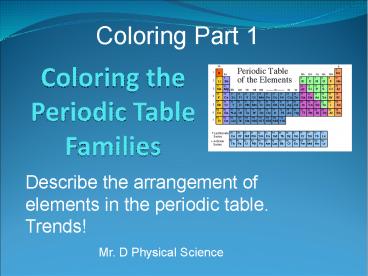Coloring the Periodic Table Families - PowerPoint PPT Presentation
Title:
Coloring the Periodic Table Families
Description:
Coloring Part 1 Describe the arrangement of elements in the periodic table. Trends! Mr. D Physical Science Directions Obtain a periodic table or download it Read ... – PowerPoint PPT presentation
Number of Views:233
Avg rating:3.0/5.0
Title: Coloring the Periodic Table Families
1
Coloring the Periodic Table Families
Coloring Part 1
Describe the arrangement of elements in the
periodic table. Trends!
Mr. D Physical Science
2
Directions
- Obtain a periodic table or download it
- Read through the PowerPoint and color as indicated
3
Period and Groups
When a column goes from top to bottom, it's
called a group. The elements in a group have the
same number of electrons in their outer orbital
(Valence).
When you look at a periodic table, each of the
rows is considered to be a different period
4
Reactivity
Alkali Metals and Halogens are very reactive
because they have either 1 or 7 valence electrons
5
Families on the Periodic Table
- Elements on the periodic table can be grouped
into families bases on their chemical properties. - Each family has a specific name to differentiate
it from the other families in the periodic table. - Elements in each family
- react differently with
- other elements.
6
ALKALI METALS
- Group 1
- Hydrogen is not a member, it is a non-metal
- Soft and silvery metals
- Very reactive, esp. with water
- Conduct electricity
- Color Light Blue
Image http//www.learner.org/interactives/periodi
c/groups2.html
7
ALKALINE EARTH METALS
- Group 2
- White and malleable
- Reactive, but less than Alkali metals
- Conduct electricity
- Color Dark Green
8
TRANSITION METALS
- Groups 3- 12
- Good conductors of heat and electricity.
- Some are used for jewelry.
- Can bond with many elements in a variety of
shapes. - Color Dark Blue
9
BORON FAMILY
- Group 13
- Most are metals
- Boron is a metalloid
- Color Red
10
CARBON FAMILY
- Group 14
- Contains metals, metalloids, and a non-metal
Carbon (C) - Color Yellow
11
NITROGEN FAMILY
- Group 15
- Can share electrons to form compounds
- Contains metals, metalloids, and non-metals
- Color Bright Green
12
OXYGEN FAMILY
- Group 16
- Contains metals, metalloids, and non-metals
- Reactive
- Color ORANGE
13
Halogens
- Group 17
- 7 electrons in the outer shell
- All are non-metals
- Very reactive are often bonded with elements from
Group 1 - Color Yellow
14
Noble Gases
- Group 18
- Exist as gases
- Non-metals
- Not reactive with other elements
- Color Grey
15
Rare Earth Metals
- Some are Radioactive
- The rare earths are silver, silvery-white, or
gray metals. - Conduct electricity
- Color Violet
16
Coloring Part 2 Color by Type
- Get another Periodic Table
- Color Code the periodic table as below
- Make a key or legend as seen below
17
- The End
- Turn in periodic table
- Answer post-project questions when completed





























